This year’s Japan Winter Wildlife Tour 1 was completed successfully on February 7, and the second tour starts today, when I release this episode, to walk you through our antics with the first group. The warm winter that kept me on my toes during the Hokkaido Landscape Tour in January continued to provide us with some challenges as a group. The Snow Monkeys, that we visit for the first three days on the tour, were just monkeys, as in, there was no snow. I’ve visited when there has been very little snow before, but this year, there was literally no snow in the valley where the monkeys live.
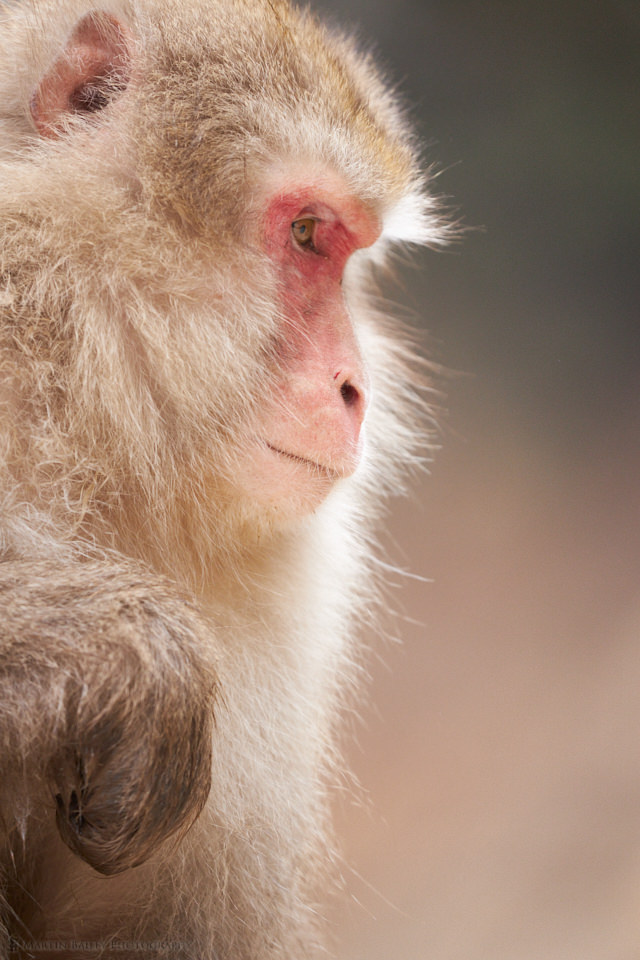
Snow Monkeys
This wasn’t ideal, but I continue to work on the premise that an opportunity lost is an opportunity gained. In this first image that I want to share from the trip, you can see the warm light of the distant valley wall behind the monkey, and the contrast allowed me to create almost a rim-light with the monkey’s fur.
The monkey was just sitting on the grain silo that is situated just after the bring from the entrance to the hot spring pool area, and often provides a nice platform for this sort of image, but usually with a white background. People talk so much about “getting something different”. Well, there you have it. 🙂
Seriously though, I do like this shot, and finding angles and backgrounds that complimented the monkeys became the theme for our time there this year. It did snow overnight on the first day in Shibuonsen, near the Monkey Park, but it was not the storm that was forecast, and pretty much melted away before the second day even got started. It was not going to spoil out fun though, so we kept plugging away at the opportunities presented to us.
In this next image (below) I used the water in the hot spring pool as a relatively neutral background, as the cloudy sky over the valley was reflecting in the water, as well as producing an almost soft-box style smooth light for our subjects.
The moment is everything with this kind of image, as the caring look of the monkey on the left lasted literally just a second, and the angle of the head on the smaller monkey, almost signifying a reciprocation of those feelings, was equally as fleeting. I can’t help but instill some of our human emotions on these close cousins of ours though, and I’m sure that at least to some degree, these feelings are not just my imagination.
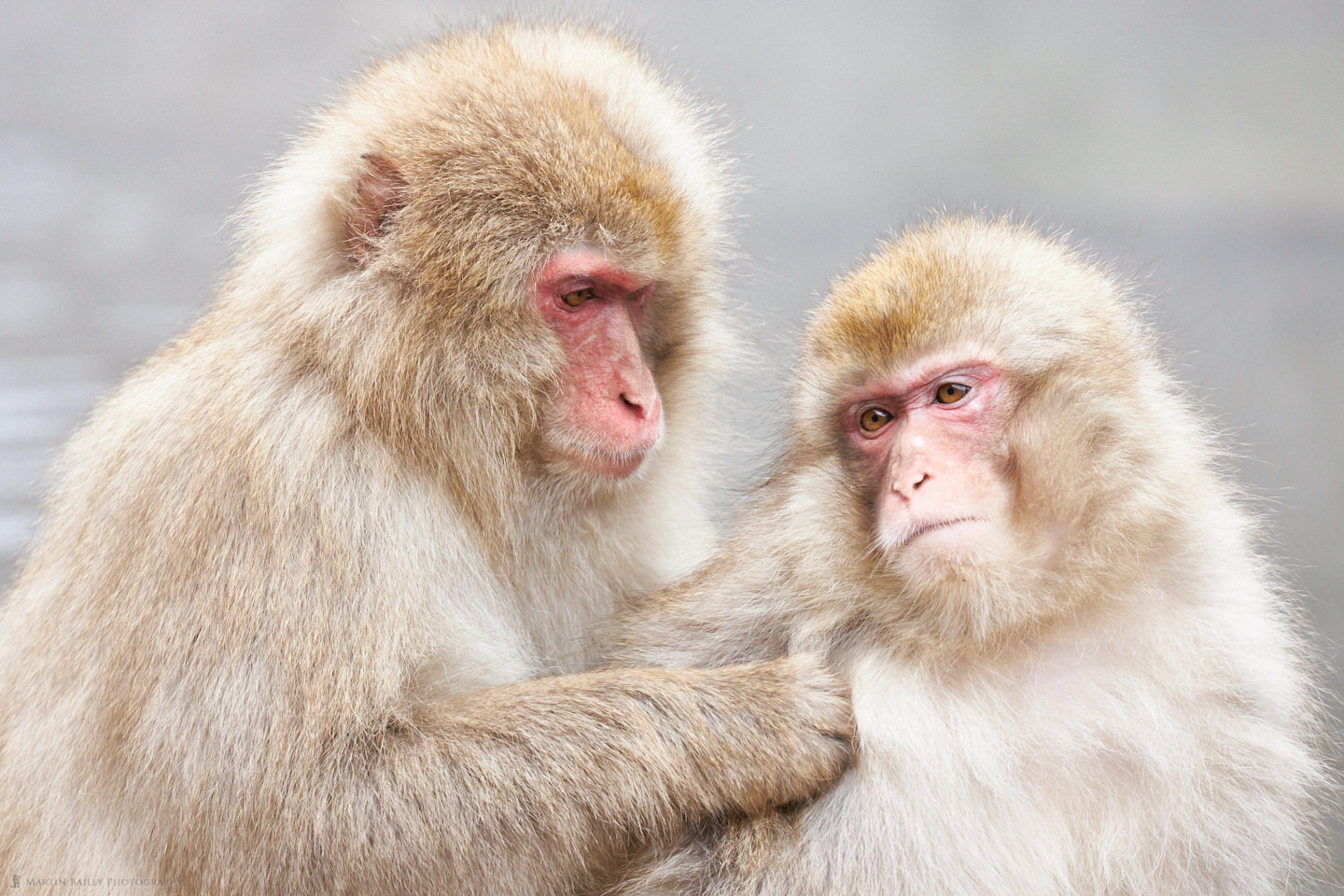
Although you can check my shooting settings by clicking on the images and viewing them in the Lightbox, to just give you an insight into my thought process, I generally try to keep a relatively fast shutter speed of around 1/500 of a second when photographing the monkeys, even when they are just sitting around like this, as their movements are often quite fast. Even just head or hand movement blurs easily with slower shutter speeds.
I also stay aware of the aperture and generally shoot multiple snow monkeys at no wider than f/8, as one of the two heads only have to be a little further or closer to the camera for one of them to be out of focus, and I prefer to avoid that when possible. When I can, I try to go to f/11 to keep multiple faces relatively sharp, as you’ll see in this next photo of the mother and child. Once I have decided on my aperture and shutter speed with this kind of consideration in mind, I control my exposure with my ISO. For the previous shot, it was at 3200, but for the mother and child shot, I changed it 6400, to give me that extra stop of sensitivity to counter the narrower aperture setting.
Another thing that I like to do, is to look for a pose like the one in this next image (right). Here I’m leading you to believe that the monkey is calm, and still, looking down into the recess at the edge of the pool. We read into this, making us feel as though the monkey is deep in thought, and that is the beauty of photography as an expressive medium. The reality is that this monkey was simply looking, again for probably less than a second, at a piece of grain that it had picked up from the pool wall, and a moment later it popped it into its mouth and continued to look feverishly for more grain.
They say that the camera never lies, and maybe it doesn’t, but the photographer is always in control of the instant at which we release the shutter, and ultimately that gives us the ability to create a mood or feeling in an image that was never there, and maybe, you didn’t need to know that.
First Cancelled Flight in 14 Years!
As fun as the snow monkeys are to shoot, and I did get a lot of shots that I am happy with, without the snow, there is only so much we could do, so we decided as a group to skip the third morning that we had planned, and we drove back to Tokyo after breakfast, and did a bit of sigh-seeing in the city before heading to the hotel where we’d spend the night, before our flight to Hokkaido, which should have been the following morning.
I say should, because ironically, having had no snow at the snow monkey, a snowstorm kicked in up in Hokkaido, and for the first time in 14 years of doing these tours, the first two flights, including ours, were canceled. The evening flight did go ahead, but Japan Airlines, despite having many people trying to travel, did not change their plane to a larger one, opting instead to leave us stranded at the airport. Luckily, we were able to book an extra night at the same hotel, although they charged almost double their usual room fees as people stranded looked for accommodation. Tired of JAL’s lack of initiative, in more ways than this, I have already instructed our travel partner for our Japan tours to book with ANA from next year.
Red-Crowned Cranes
We were able to get seats on the first flight the following morning, and the snow that had prevented us from flying provided us with a much welcome covering of snow as we settled into some of the best Red-Crowned Crane photography we’ve had for a few years. Truth be told, there are actually two complete cranes cloned out either side of these two singing together, but still, just having the birds themselves framed without other birds overlapping, and on good snow, was a bit of a treat.
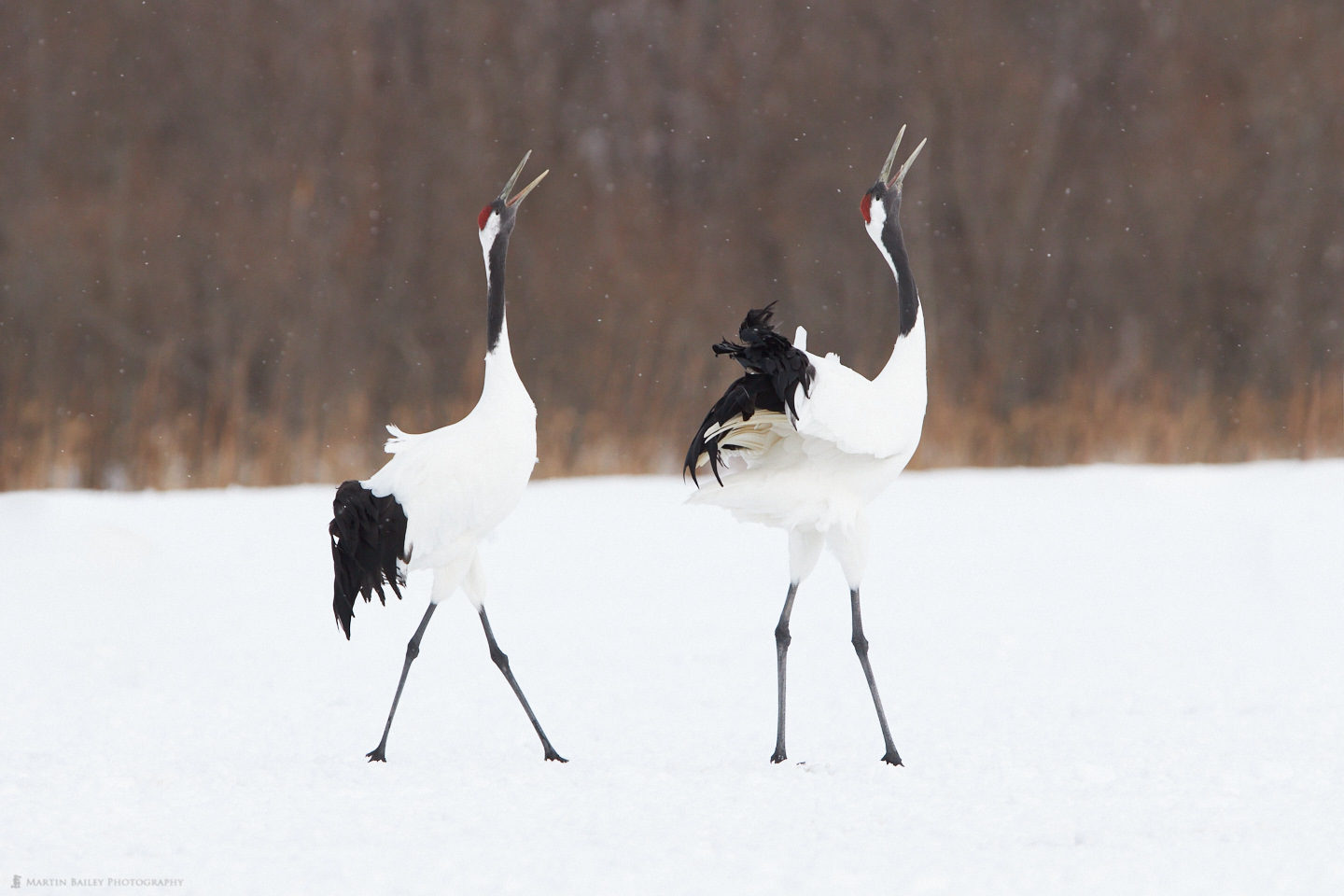
This shot also nicely illustrates the answer to a pop-quiz question that I often put to my tour guests while at the cranes. I ask what color the cranes tail is, and 99% of the time the answer that I get is “black” because people usually see what we have here on the left. But if you look at the crane on the right here, you’ll see that the tail of the bird is actually pure white. The plume of black feathers that looks like a tail on the bird on the left is actually the feathers that line the back edge of their wings.
During what you might consider the down-time that we get at the cranes, while there are no birds flying in or out, or dancing or singing, I often just scour the field for birds like the one you see in this next image, just feeding, or preening. They are often close enough to almost fill the frame with the animal like this, and I enjoy just poring over the detail in these shots.
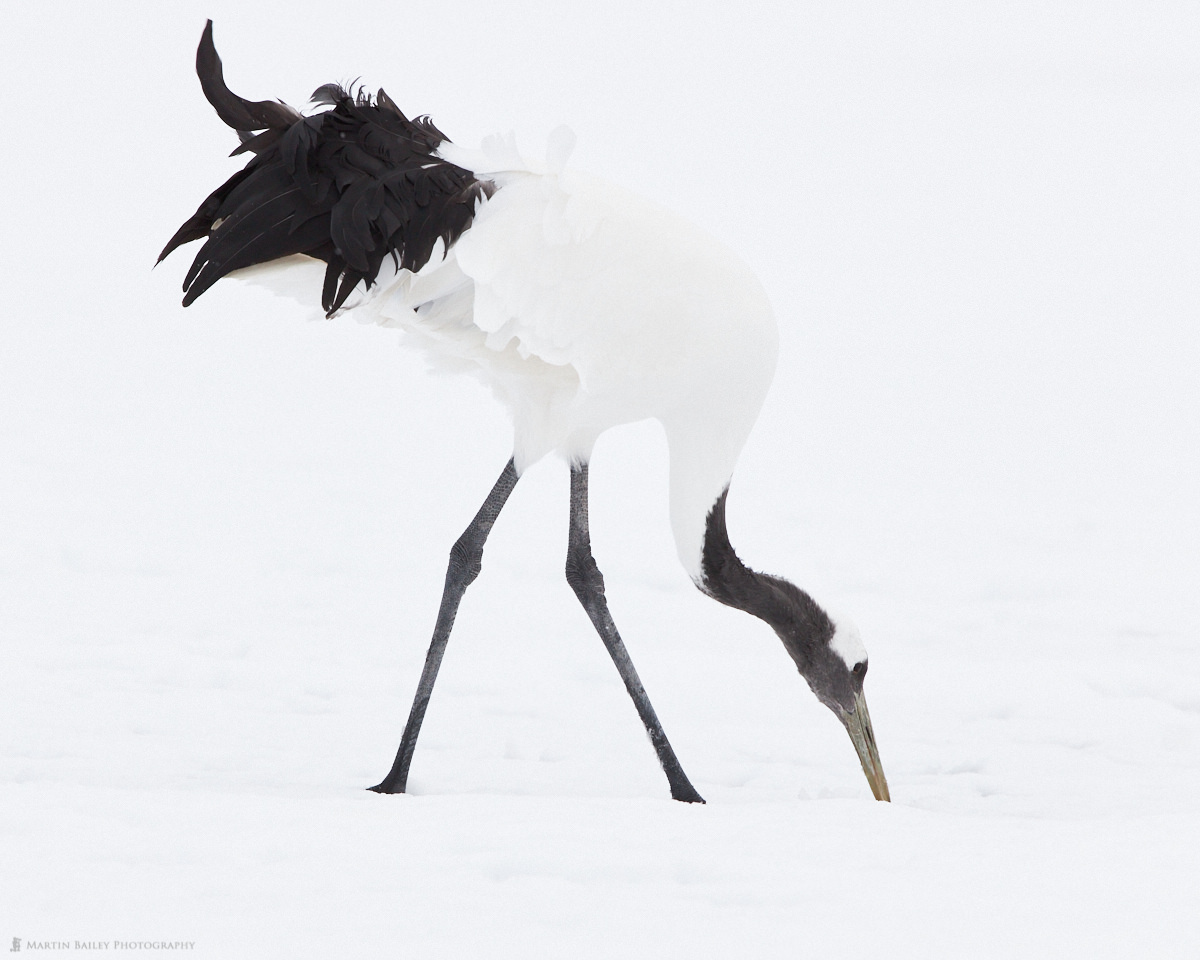
I cropped this down to a 4:5 aspect ratio, as there was obviously a lot of white space either side of the crane. I like to stick to standard cropping ratios like 4:5, square, or if wider I like 16:9 and even 2:1. The main reason is for conformity when printing, except for 16:9 which is more just because images look great on the TV at this standard wide-screen ratio.
Ural Owl
In the middle of the afternoon on our first day in Hokkaido, I took the group to a Ural Owl’s nest, to get photos like this one, which was shot with my 200-400mm lens with the built-in 1.4X Extender engaged and a 2X Extender fitted, giving me a focal length of 1,120mm. It’s amazing that autofocus still works down at f/11, which is the aperture I’m forced to from f/4 with three stops of extender fitted, but it works pretty well, and the image quality is absolutely fine with the Canon EOS R.
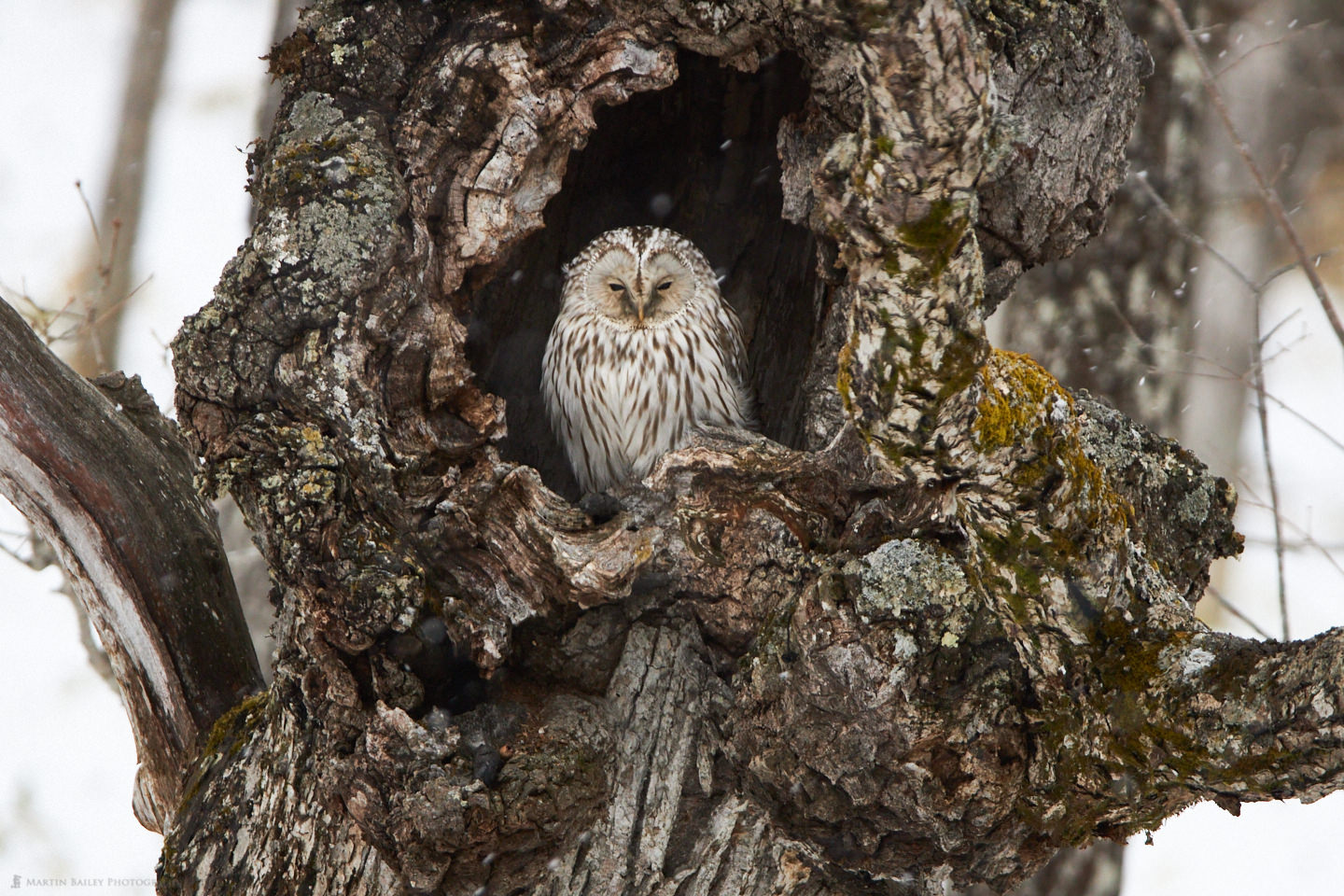
There aren’t many opportunities for different angles at this location, and we have to shoot from a distance to protect the owls, and that’s fine. After this, the owl actually regurgitated a pellet, which is the bones of mice or other animals that the owl has eaten, wrapped perfectly in their fur. He stretched his head up, so I thought that was what he was going to do, then he leaned forward and ejected the pellet. I have a shot in which you can see the pellet coming out of his mouth, but it’s not very pretty, so I’ll share this straight shot for now.
More Cranes
The last location for the day was to do some panning shots as the crane’s left to go to the river to roost for the night. I really enjoy this kind of photography and love it when we get a few flight-outs to enable the group a number of chances to nail a few of these shots. I slow my shutter down to around a 1/50 of a second for panning shot, as I find this gives a good balance between getting more shots that work and still being aesthetically pleasing.
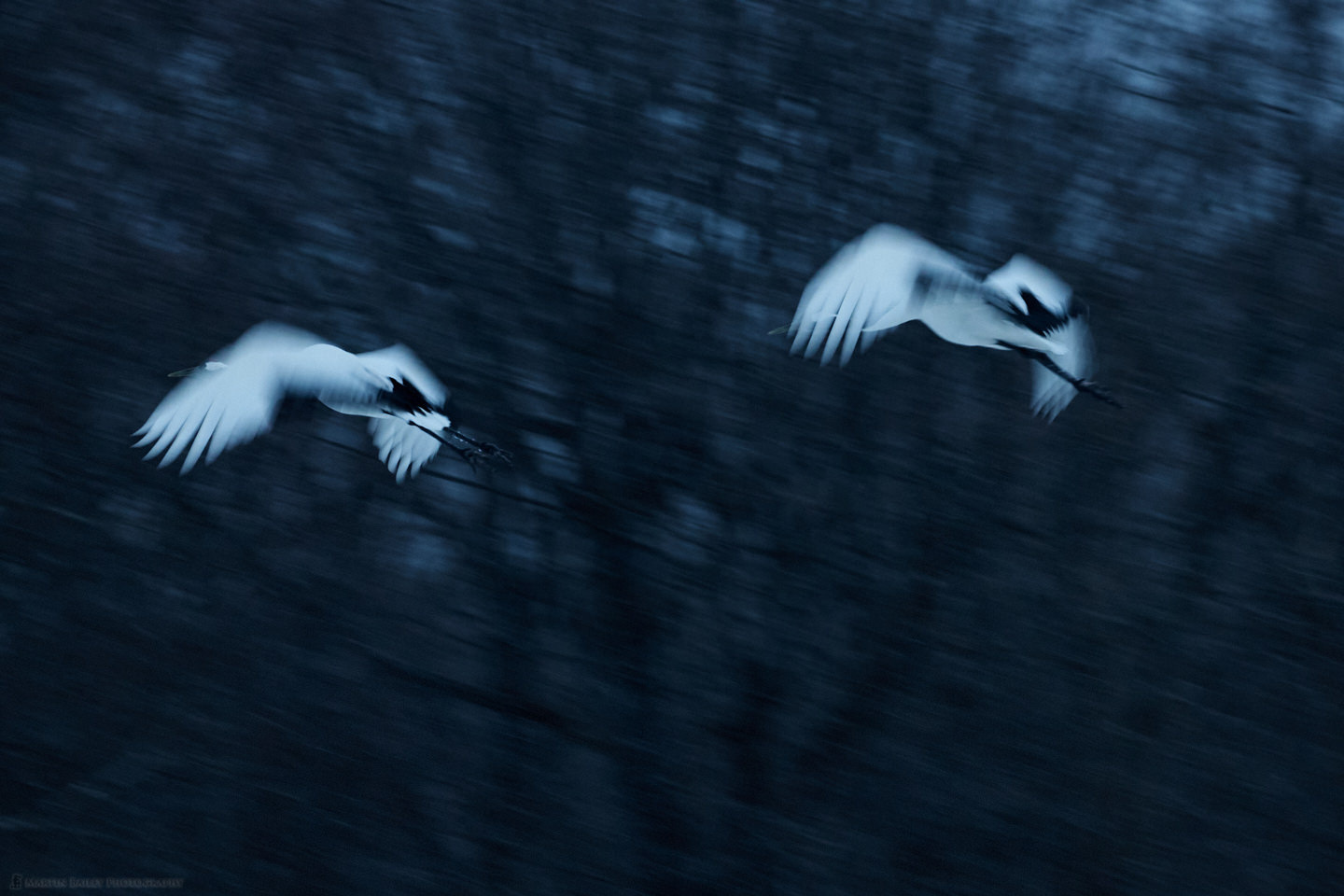
I like how the heads of the cranes in this shot are visible through their blurred wings. I also find that with these birds being predominantly white, they look great over a black background, so I’ve actually darkened the shadows slightly with the levels slider and Luma Tone Curve in Capture One Pro.
The previous four shots were all from day one with the cranes, but that should have been day two, so instead of moving on to the Whooper Swans the following morning, we went back to the crane until lunchtime, giving us a number of other opportunities. The first of which is this group of four cranes coming in to land. The first crane perhaps landed a little bit sooner than the others had hoped, causing them to stack up like this.
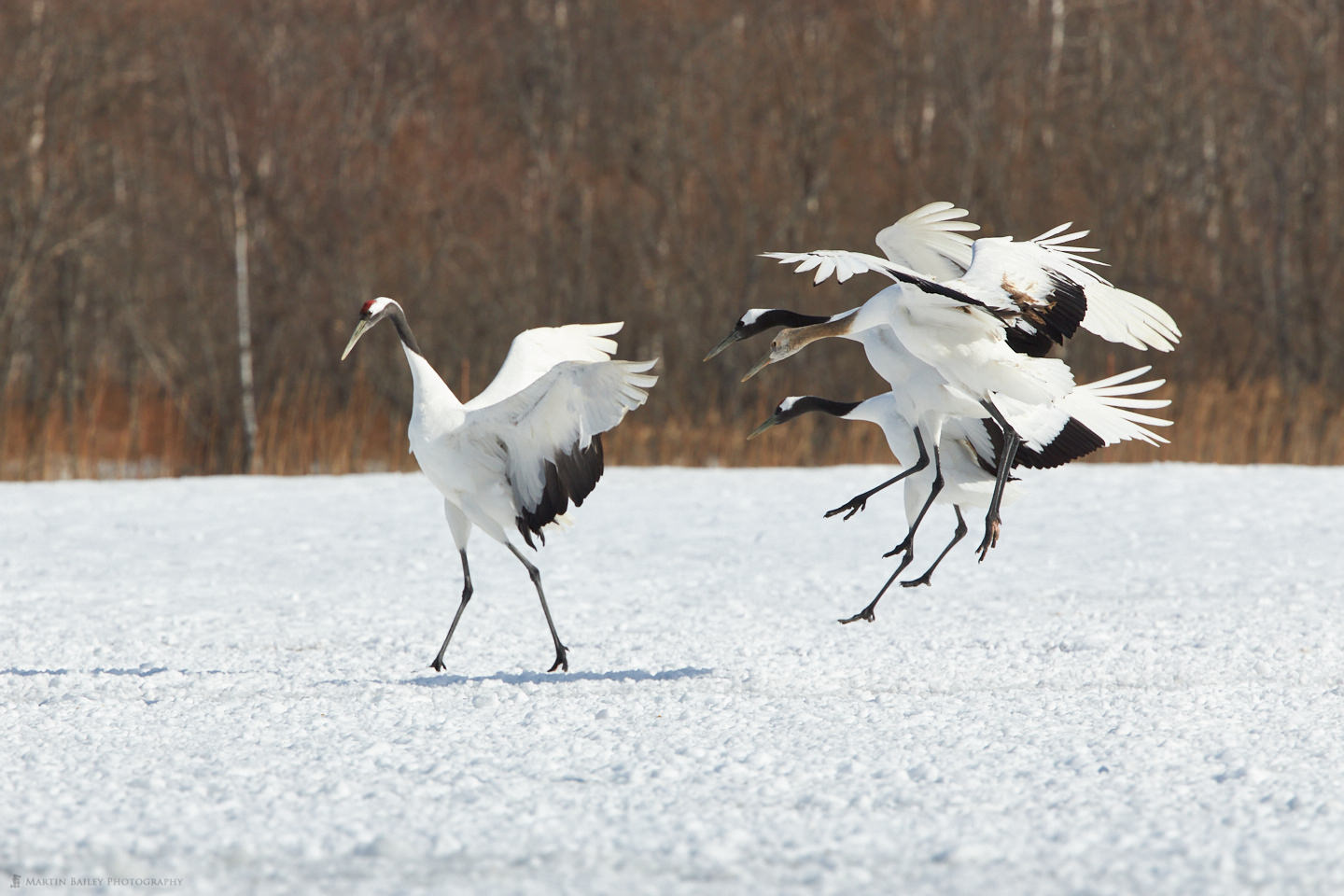
It was also really nice, as with the earlier photo, to get some crane action in an opening. Even on this trip, most of the landings happened behind other cranes, but more than in recent years, there were landings in openings like this.
It also pays to watch the birds after they land, as I find that especially with tall birds like these cranes, they often arch their backs probably to relieve the tension in their muscles from flying, and this time, the three adults in this group all did just that, as you can see here.
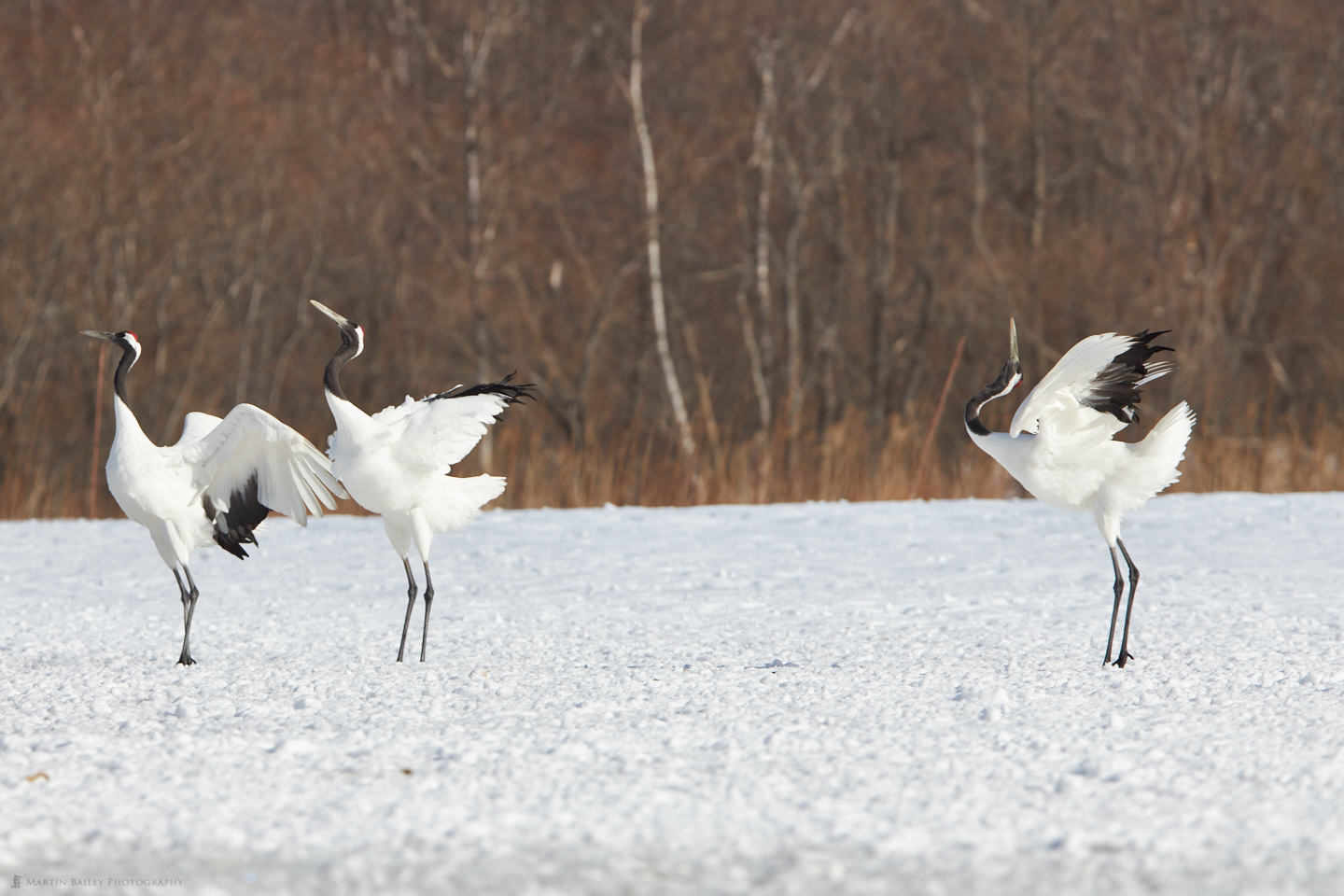
I’m not a big fan of the space between the birds in this shot, but it was nice to get three of them arching together, and without having to clone out any other birds, so I’m happy with this.
We’ll wrap it up there for this week, as that brings us to 10 images. If you would like to join the 2021 Japan Winter Wildlife Tour, please note that it is already full, but you can contact me to join the cancellation list, which is still relatively short at the time of releasing this podcast. Sign up for our newsletters for notification of the 2022 tour when I start taking bookings or check out the Tours and Workshops page, as I plan to start taking bookings very soon!
I am preparing this on the Friday before release, and I’m trying frantically to release version 3.2 of my Photographer’s Friend app with some great new functionality, so I’m probably going to have to skip next week again. Sorry about that, but for any Photographer’s Friend users among you, I think you’ll appreciate the work I’ve put into it over this last week. For the Android users that are still waiting, I will try my hardest to get you an Android version this year.
Show Notes
Check our Tour & Workshops page for details of future tours! http://mbp.ac/tours
Audio
Subscribe in iTunes to get Podcasts delivered automatically to your computer.
Download this Podcast as an MP3 with Chapters.
Visit this page for help on how to view the images in MP3 files.

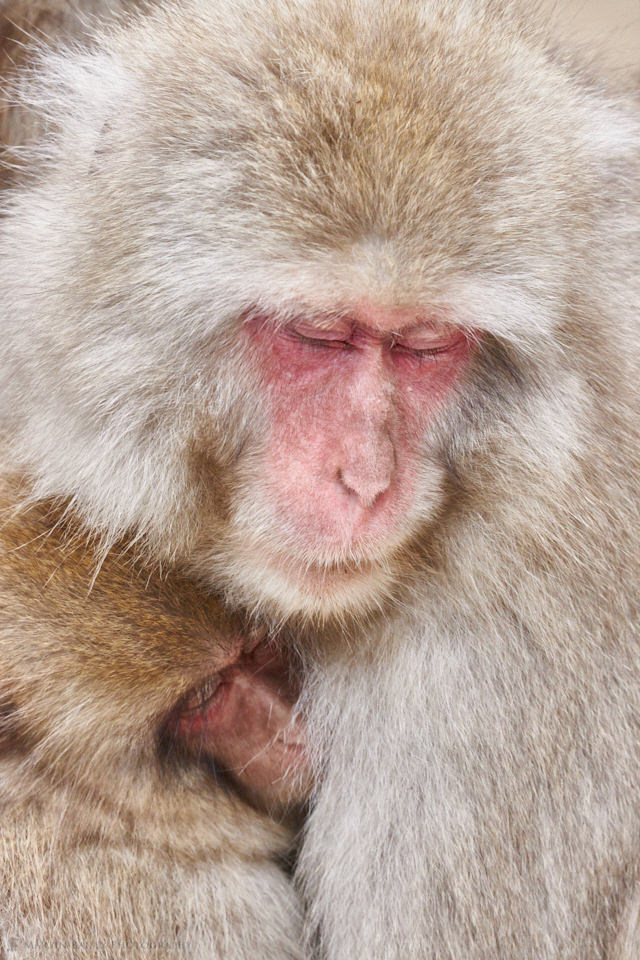
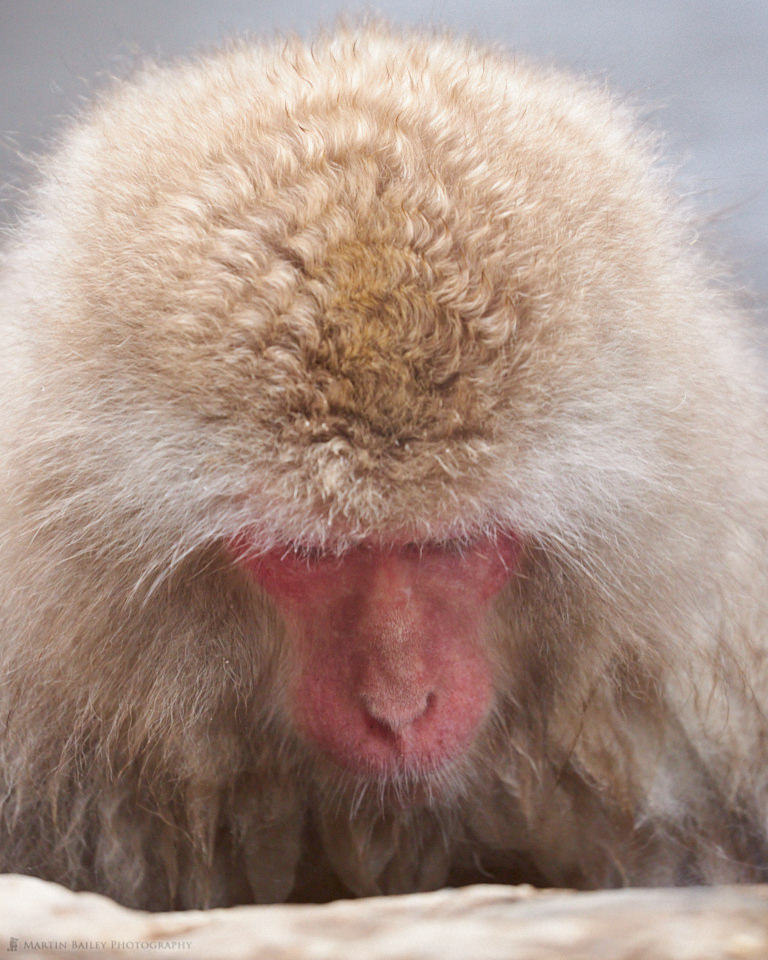

0 Comments